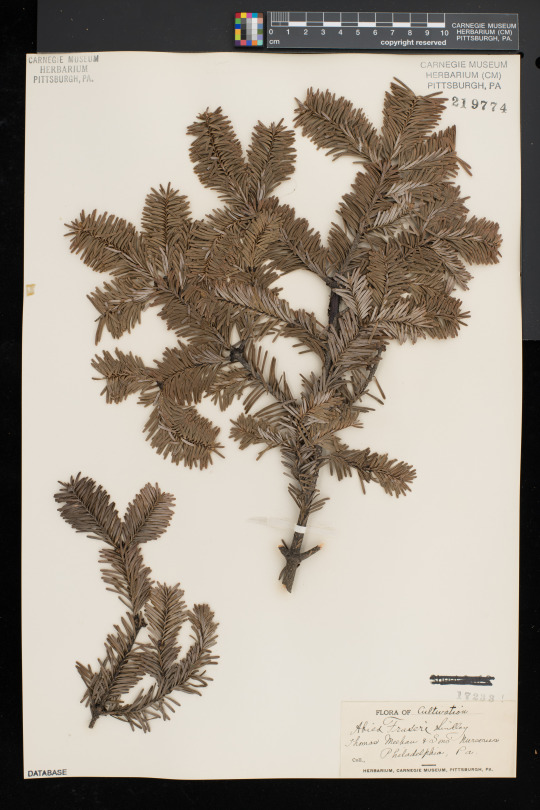by Mason Heberling

Collected on some day, probably between 101-122 years ago.
Around 25-30 million cut trees are sold each year in the United States for the holidays. The popularity of certain species for this use has changed through time. Many different evergreen conifer species are cultivated in the US for decorative use during the holidays. Needle length, softness, retention, color, and even scent vary by species or variety. Similarly, branching characteristics and branch strength differs by species. Plus, some species grow faster and easier than others, which means some species are cheaper.
This specimen of Fraser fir (Abies fraseri) was collected in Philadelphia at the Thomas Meehan & Sons Nursery. The person who collected this specimen and the date of collection are unknown. Thomas Meehan immigrated to the United States from England in 1848 and started a landscaping business. With his three sons, he started the Thomas Meehan & Sons Nursuries in 1896. The nursery was unique in that it specialized in native trees and shrubs, unlike most nurseries that focused on European and Asian varieties (still very common today). The nursery closed in 1916.
Fraser fir is currently one of the most popular Christmas trees. It is known for its dark green color, soft needles, stiff branches (great for hanging heavy ornaments), and has good needle retention. Unfortunately, native to the Southern Appalachians, Fraser fir isn’t the easiest to grow in Pennsylvania.
Before farms began cultivating trees for that purpose in the early 20th century, people just went to the woods to cut down their tree for the holidays. Some of the earliest Christmas tree farms in the US started in Indiana County, PA as early as 1918. Many farms in the region turned their fields into Christmas tree farms as it became profitable. By 1960, more than 1 million trees were harvested per year in Indiana County alone. The harvest in Pennsylvania has declined for several reasons, including increased popularity of artificial trees and consumer interest in Frasier fir trees (grows slower in PA than farms in North Carolina). However, Pennsylvania is still among the top five states in terms of both number of working Christmas tree farms and trees harvested. According to the National Christmas Tree Association, 31,577 acres in Pennsylvania are used as Christmas tree plantations. Many of the Christmas tree lots in southwestern PA get their trees from farms in Indiana county.
Check back for more! Botanists at the Carnegie Museum of Natural History share digital specimens from the herbarium on dates they were collected. They have embarked on a three-year project to digitize nearly 190,000 plant specimens collected in the region, making images and other data publicly available online. This effort is part of the Mid-Atlantic Megalopolis Project (mamdigitization.org), a network of thirteen herbaria spanning the densely populated urban corridor from Washington, D.C. to New York City to achieve a greater understanding of our urban areas, including the unique industrial and environmental history of the greater Pittsburgh region. This project is made possible by the National Science Foundation under grant no. 1801022.
This specimen image is now online and publicly available here.
Mason Heberling is Assistant Curator of Botany at Carnegie Museum of Natural History. Museum employees are encouraged to blog about their unique experiences and knowledge gained from working at the museum.
Related Content
A Perfect Mineral for the Christmas Season
Ask a Scientist: What makes poinsettias so special?
Collected on Christmas Eve 1883: Mistletoe
Carnegie Museum of Natural History Blog Citation Information
Blog author: Heberling, MasonPublication date: December 12, 2018
